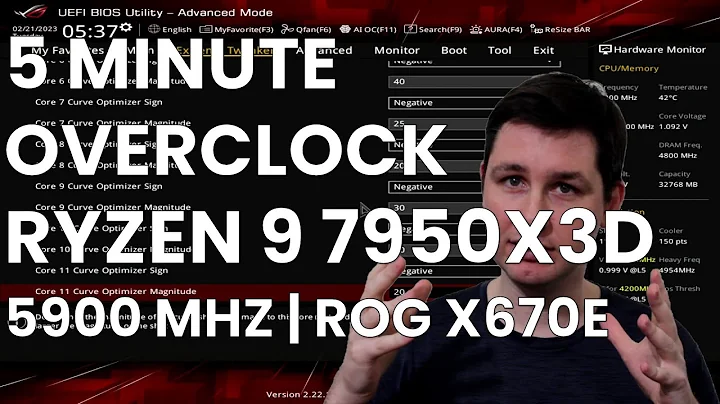Solving the Heating and Power Consumption Issues with Intel Processors
Table of Contents:
- Introduction
- The Issue with Intel Processors
- A Brief Explanation of the Problem
- Solutions for Overheating and High Power Consumption
- The Importance of CPU Cooling
- Understanding Voltage and Power Settings
- Using Intel XTU for Overclocking
- What is Intel XTU?
- How to Optimize Performance with Intel XTU
- The Impact on Gaming Performance
- The Importance of Stability testing
- Balancing Power Consumption and Performance
- The Role of VRM Temperatures
- Addressing Misconceptions about Intel Processors
- Conclusion
The Issue with Intel Processors and How to Solve It
In recent years, there has been a growing concern about the heating and power consumption of Intel processors. Many users have complained about these issues, leading to the misconception that Intel processors are inherently flawed. However, it's essential to understand that there are solutions available to address these problems effectively.
The Issue with Intel Processors
Intel processors have been known to exhibit high temperatures and power consumption, especially when under heavy load. This is primarily due to the desire to maintain top performance while dealing with demanding tasks. The demand for power puts a strain on the processor and can result in peak temperatures that may seem alarming to users. While it's true that Intel processors can run hot, it's important to note that they are not at risk of catching fire or permanently damaging the system.
Solutions for Overheating and High Power Consumption
The key to addressing the heating and power consumption issues with Intel processors lies in optimizing cooling and power settings. By implementing the following solutions, users can effectively manage and control these concerns.
The Importance of CPU Cooling
One of the most critical factors in mitigating the heating problem is proper CPU cooling. Ensuring that your processor stays within safe operating temperatures typically involves investing in high-quality cooling solutions such as liquid cooling systems or robust air coolers. These cooling solutions help dissipate the heat generated by the processor, preventing it from reaching critical levels.
Understanding Voltage and Power Settings
Another crucial aspect of managing Intel processor temperature and power consumption is optimizing voltage and power settings. Intel XTU (Extreme Tuning Utility) is a powerful tool that allows users to adjust these settings to find the right balance between performance and power usage. By fine-tuning parameters such as the Vcore (core voltage) and maximum power boost, users can reduce power consumption without significantly impacting performance.
Using Intel XTU for Overclocking
Intel XTU, primarily known as an overclocking tool, can also be used to optimize processor performance while effectively managing heating and power consumption. By making adjustments within the Intel XTU interface, users can achieve better results in terms of both stability and power efficiency.
What is Intel XTU?
Intel Extreme Tuning Utility (XTU) is a software application designed to optimize Intel processors based on the Windows operating system. It provides a user-friendly interface that allows users to tweak various parameters, including clock speed, voltages, and power settings. While overclocking is one of its primary functions, Intel XTU offers much more, such as real-time monitoring, stress testing, and profile saving.
How to Optimize Performance with Intel XTU
To achieve optimal performance and manage power consumption with Intel XTU, users should follow these steps:
- Install and launch Intel XTU on your Windows system.
- Familiarize yourself with the user interface and learn about the available settings and options.
- Start by adjusting the Vcore voltage and gradually test its impact on stability and power consumption.
- Monitor the temperatures and power usage while stress testing the system.
- Fine-tune other settings, such as power boost and frequency, to find the right balance between performance and power consumption.
- Perform stability testing to ensure that the system can handle the adjusted settings without crashing or overheating.
- Save and apply your optimized profile for consistent usage.
The Impact on Gaming Performance
When it comes to gaming, Intel processors are more than capable of delivering excellent performance. While the heating and power consumption issues may be a concern, they typically have minimal impact on gaming performance. The bottleneck in gaming is often the graphics card, and as long as the processor can keep up with it, users can expect smooth gameplay with Intel processors.
The Importance of Stability Testing
Achieving stability is crucial when optimizing Intel processors for better performance and power efficiency. To ensure that the system can handle the adjusted settings, users should perform stability tests using tools like Prime95 or Intel XTU's built-in stress test feature. Stability testing helps identify any instability issues, such as crashes or overheating, allowing users to fine-tune their settings for optimal results.
Balancing Power Consumption and Performance
Finding the right balance between power consumption and performance is key when optimizing Intel processors. While reducing power consumption can lead to lower temperatures and potentially longer lifespan, it's essential to strike a balance that still provides the desired performance. Each system is unique, and users may need to experiment with different settings until they find the optimal configuration that suits their needs.
The Role of VRM Temperatures
In addition to CPU cooling, users should also pay attention to VRM (Voltage Regulator Module) temperatures. VRMs play a crucial role in delivering stable power to the processor, and their temperatures can significantly impact performance and efficiency. To ensure proper VRM cooling, users should consider using a reliable motherboard with robust VRM design and cooling solutions, such as heatsinks or fans.
Addressing Misconceptions about Intel Processors
It's important to address some common misconceptions surrounding Intel processors. While it's true that certain Intel processors may exhibit higher power consumption and temperatures compared to their counterparts from other manufacturers, it doesn't necessarily mean that they are inherently inferior. Intel processors offer excellent performance in various applications, especially when optimized correctly.
Conclusion
In conclusion, the heating and power consumption issues associated with Intel processors can be effectively managed and optimized by implementing proper cooling solutions, adjusting voltage and power settings using tools like Intel XTU, and striking a balance between power consumption and performance. With the right approach, users can enjoy the full potential of their Intel processors without compromising stability or longevity.
Highlights:
- Intel processors are known to exhibit high temperatures and power consumption under heavy load.
- Proper CPU cooling and optimized voltage/power settings are crucial for managing overheating and power consumption issues.
- Intel XTU can be used for overclocking and optimizing performance with Intel processors.
- The impact on gaming performance is minimal, as the bottleneck is typically the graphics card.
- Stability testing helps ensure that adjusted settings are stable and reliable.
- Balancing power consumption and performance is key to optimizing Intel processors.
- VRM temperatures should be considered for optimal performance and efficiency.
- Misconceptions about Intel processors should be addressed, as they offer excellent performance when optimized correctly.
Resources:
FAQ:
Q: Are all Intel processors prone to overheating and high power consumption?
A: While some Intel processors may exhibit higher temperatures and power consumption, it's important to optimize cooling and power settings for each specific processor.
Q: Can Intel XTU be used for processors other than Intel?
A: Intel XTU is primarily designed for Intel processors and may not work optimally with processors from other manufacturers. It's recommended to use tools specific to those processors.
Q: Does reducing power consumption impact processor performance?
A: Striking the right balance between power consumption and performance is crucial. While reducing power consumption can lower temperatures and potentially extend lifespan, it's important to ensure that the system's performance meets the desired requirements.
Q: Are Intel processors suitable for gaming despite the heating and power consumption concerns?
A: Yes, Intel processors are capable of delivering excellent gaming performance. The heating and power consumption issues typically have minimal impact on gaming, as long as the processor can keep up with the graphics card's demands.
 WHY YOU SHOULD CHOOSE TOOLIFY
WHY YOU SHOULD CHOOSE TOOLIFY
































